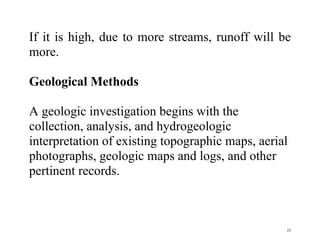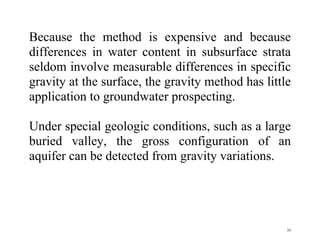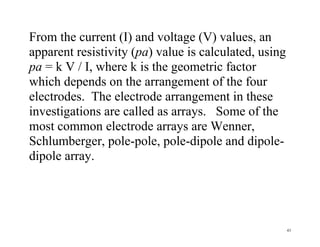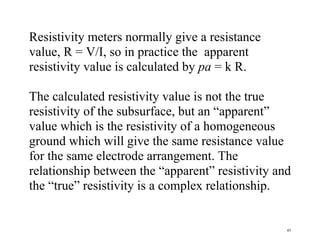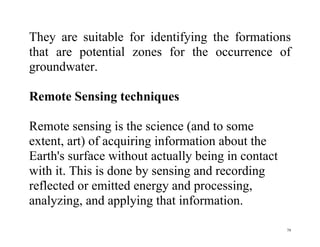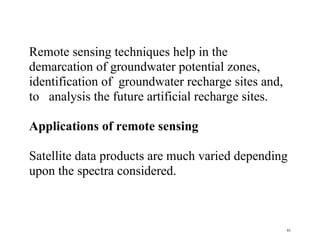Groundwater exploration methods
- 1. 1 Groundwater Exploration Methods BY PROF. A. BALASUBRAMANIAN Centre for Advanced Studies in Earth Science, University of Mysore Mysore
- 2. 2 Objectives : After attending this module, the user would be able to know about the most popular methods of groundwater exploration. The surface geomorphological, geological, structural, hydrogeological, geophysical and remote sensing methods will be known. In addition, the user will also get some basic ideas about the subsurface methods of groundwater exploration like well-logging and test drilling.
- 3. 3 Introduction Groundwater is an invisible natural resource. It is available in different proportions, in various rock types and at various depths, on the surface layer of the earth. In the historical past, when there is no visible flow of water along the rivers, people used to dig small pits, in the river alluvium, wait and collect the groundwater coming through seepage and use it for their drinking purposes and for meeting the domestic needs.
- 4. 4 Similarly, to the people of mountainous regions, natural springs provided the sources of water supply. Springs are the outcome of seepage from any groundwater system, in hilly terrains or in limestone regions. More than 60 percent of the global population thrives by using only the groundwater resources. The groundwater which was existing at shallow depths in the open wells, has gone deep due to over-exploitation.
- 5. 5 Exploring these water sources become a challenging task to geo-scientists. Renewable resource Groundwater is a renewable source. Groundwater gets replenished after every rainfall. This is called as rainfall recharge. The level of water seen in an open well denotes the uppermost surface of the zone of saturation of the porous media. This is called as the water table.
- 6. 6 After every recharge, the water table raises, denoting that the porous media has saturated with more water. When we pump out water, the water level goes down. Continuous pumping of water, beyond the recharge, will make the wells go dry and force to deepen the well. The search of groundwater got increased, due to the non-availability of sources and due to the declining water tables.
- 7. 7 Heterogeneous distribution Groundwater is not uniformly distributed everywhere. The occurrence of groundwater varies from formation to formation. In a typical crystalline hard rock terrain, the quantitative occurrence of groundwater depends on the weathered and fractured zones. The occurrence of groundwater in a sedimentary terrain will be more promising.
- 8. 8 Groundwater prospecting is a very thought provoking scientific exercise in most of the places. There is a need to understand the methods of groundwater exploration, as it is a practical decision-making approach. This module highlights some of the general methods of groundwater exploration. Exploring groundwater
- 9. 9 Groundwater exploration is a typical task of a hydrogeologist or an engineer. Identifying the location of its availability is a challenging task. Exploration of groundwater requires a basic understanding of its position in the subsurface geological setup. Groundwater Exploration is attempted through either by direct or indirect methods. Test drilling is the direct approach to find out the resource. This is an expensive affair.
- 10. 10 Every individual can not go for test drilling. During the last two centuries, more and more techniques have been developed to explore the groundwater. They are classified into surface and sub-surface methods. Surface methods The surface methods are easy to operate and implement.
- 11. 11 These require minimum facilities like topo-sheets, maps, reports, some field measurements and interpretations of data in the laboratories. The surface methods of groundwater exploration include the following: –Esoteric Methods –Geomorphologic methods –Geological & structural Methods –Soil and Micro-Biological Methods –Remote Sensing Techniques –Surface Geophysical Methods
- 12. 12 Subsurface methods The subsurface methods of groundwater exploration includes both Test Drilling & Borehole Geophysical Logging techniques. When compared to the surface methods, the subsurface methods are very expensive. These are done for government level projects where large scale investigations are carried out to ascertain the results of surface surveys.
- 13. 13 The subsurface methods are very accurate methods as the help in direct observations of features in the form of bore-hole lithologs as core samples and also geophysical measurements of formation properties. Esoteric methods The Esoteric methods are the ancient methods. These are the oldest water divining methods practiced by ancient people for several centuries. They are also called as water-dowsing.
- 14. 14 People believed that the flow of groundwater can induce some vital currents above the surface. When a wet plant twig is moved above such zones, it tends to rotate the twig as well. Wet twigs of trees, husk-removed coconuts, watches and other materials have been used as dowsing materials. The person handling the twig has some role of induction and hence it is not applicable to everybody attempting to divine water. All these methods have been practiced since 17th century.
- 15. 15 There is no scientific explanation available with reference to these approaches. Probability of success is a mere coin-tossing experiment. These methods are called as water divining. Water Witching Water witching is a traditional method adopted by people to detect bore-well locations. Using a forked stick to locate water source is known as water witching.
- 16. 16 Although this method is lacking any scientific justification for the method, water witches diligently practice the art wherever people can be persuaded of its potential value. Commonly, the method consists of holding a forked stick in both hands and walking over the local area until the butt end is attracted downward-ostensibly by subsurface water. It is amazing that the idea of supernatural powers has such a continued fascination for people to use despite its limitations.
- 17. 17 Geomorphological Methods Surface drainage is the subdued replica of topography. It is controlled by the basement rocks. Mostly, groundwater flow coincides with the surface drainages. The streams and water courses may also be controlled by some underlying structures. Junctions of streams at the down slopes are promising zones for groundwater. Landforms originate due to several geological processes.
- 18. 18 Some of them are likely to contain relatively permeable strata. River-borne modern alluvial terraces, floodplains, stratified valley-fill deposits in abandoned channels, glacial outwash and moraine deposits are good landforms for groundwater. Alluvial fans, beach ridges, partly drift-filled valleys, sand dunes, moist depressions, and marshy environments are good localities.
- 19. 19 Study of Land forms Landforms are the likely indicators to show the relatively permeable strata. The locations of modern alluvial terraces and floodplains, stratified valley-fill deposits, glacial outwash plains, glacial deltas, kames , moraine complexes, eskers, alluvial fans and beach ridges are good locations for groundwater occurrence.
- 20. 20 Partly drift-filled valleys marked by a chain of elongate closed depressions, largely masked bedrock valleys cutting across modern valleys that are indicated by local non- slumping of weak shale strata in valley sides, sand dunes assumed to overlie sandy glacio- fluvial sediments, nearby locations of lakes and streams are very good indicators for groundwater prospecting.
- 21. 21 Topography and Drainage Physiographic methods analyse the surface topography and drainages. The locations of confluence and junctions of surface streams at the downstream points of small watersheds are good locations for groundwater for confluence. Hydraulic gradients of groundwater systems will always follow the topographic gradients and slopes.
- 22. 22 Such locations are also suitable for water collection and storage for recharge. Drainage density of stream network Drainage density is the ratio between the total length of all streams and the area of watershed or river basin. The resultant drainage density is used to indicate the potentiality of groundwater. If the drainage density is low, groundwater potentiality will be more.
- 23. 23 If it is high, due to more streams, runoff will be more. Geological Methods A geologic investigation begins with the collection, analysis, and hydrogeologic interpretation of existing topographic maps, aerial photographs, geologic maps and logs, and other pertinent records.
- 24. 24 This should be supplemented, when possible, by geologic field reconnaissance and by evaluation of available hydrologic data on stream flow and springs, well yields, groundwater recharge, discharge, and levels and water quality. In some places, the drainages may be fully controlled by the presence of minor and major structures like joints, faults and lineaments. Such zones are good and potential zones for groundwater exploration. These are the conduits for groundwater flow.
- 25. 25 Structural methods Contact points between permeable water-bearing strata overlying relatively impermeable strata- usually along the sides of valleys that cut across the interface between different strata are suitable locations for groundwater. Springs occurring on or near the base of hillsides, valley slopes, and local scarps are indicators of groundwater occurrence over hilly terrain.
- 26. 26 Dykes are good barriers for arresting the flow of groundwater. Location of dykes and analyzing their dip and strike help in selecting the groundwater potential zones in the upstream side. Well-inventory Well-inventory is a method of analyzing the well- cuttings and inner surfaces of open dug wells to know about the subsurface geology, structures, seepage zones, fluctuations of water levels, rate of recovery after pumping and the geo- environmental setting of the wells in a region.
- 27. 27 This method helps to analyse the data collected from more number of the wells of a region and come to a conclusion about the regional groundwater potentialities. The groundwater flow paths could be easily identified through well-inventory. Promising zones could be identified for further investigations though this method.
- 28. 28 Soil and Micro-Biological Methods Geo-botanical indicators are valuable tools in groundwater exploration. The anomalous growth of vegetation and alignment of big trees on a straight line, growth of termite mounds and location of age old, deep rooted heritage trees can indicate the occurrence of groundwater at shallow depths. Presence of Halophytes, plants with a high tolerance for soluble salts, and white efflorescence of salt at ground surface, indicate the presence of shallow brackish or saline groundwater.
- 29. 29 Xerophytes, the well-known desert plants , subsisting on minimal water, suggest a considerable depth to the water table. All these are supplementary tools in detecting the locations of groundwater zones. Moist depressions and seepages Moist depressions, marshy environments, and seepages, string of alkali flats or lakes (playas) along inactive drainage systems, salt precipitates (e.g., salt crusts),
- 30. 30 localized anomalous-looking "burn out" patches in the soil, and vegetation associated with salt migration and accumulation are good indicators for groundwater availability. Depression springs, where land surface locally cuts the water table or the upper surface of the zone of saturation, Contact springs containing a permeable water-bearing strata overlying relatively impermeable strata-usually along the sides of valleys that cut across the interface between different strata are good locations.
- 31. 31 The presence of artesian springs occurring on undulating upland till plains, and artesian springs occurring on or near the base of hillsides, valley slopes, and local scarps are very good indicators. Geophysical methods Exploring the ground water by geophysical method is termed Ground water geophysics.
- 32. 32 Geophysical investigations are conducted on the surface of the earth to explore the ground water resources by observing some physical parameters like density, velocity, conductivity, resistivity, magnetic, electromagnetic & radioactive phenomena. Geophysical methods comprise of measurement of signals from natural or induced phenomena of physical properties of sub surface formation. Geophysical methods detect the differences, or anomalies of physical properties within the earth's crust.
- 33. 33 Density, magnetism, elasticity, and electrical resistivity are properties that are most commonly measured. The purpose of exploration is to detect the indirect indicators and locate the potential zones for exploitation. The main geophysical methods which are useful in solving some of the problems of hydrogeology, are the Electrical, Seismic, Gravity, and Magnetic methods.
- 34. 34 Gravity Method The gravity method is a widely used geophysical method for finding out mineral resources and groundwater in sedimentary terrain. Gravimeters are used in this method to measure the differences in density on the earth's surface that may indicate the underlying geologic structures.
- 35. 35 Because the method is expensive and because differences in water content in subsurface strata seldom involve measurable differences in specific gravity at the surface, the gravity method has little application to groundwater prospecting. Under special geologic conditions, such as a large buried valley, the gross configuration of an aquifer can be detected from gravity variations.
- 36. 36 Magnetic Method The magnetic method enables detecting the magnetic fields of the earth which can be measured and mapped. Magnetometers are the equipments used to measure the magnetic fields and variations. Because magnetic contrasts are seldom associated with groundwater occurrence, the method has little relevance for exploring groundwater.
- 37. 37 Seismic Method Seismic methods are of two kinds as seismic refraction and reflection methods. The seismic refraction method involves the creation of a small shock at the earth's surface either by the impact of a heavy instrument or by a small explosive charge and measuring the time required for the resulting sound, or shock, wave to travel known distances.
- 38. 38 Seismic waves follow the same laws of propagation as light rays and may be reflected or refracted at any interface where a velocity change occurs. Seismic reflection methods provide information on geologic structure thousands of meters below the surface, whereas seismic refraction methods-of interest in groundwater studies-go only about 100 meters deep. The travel time of a seismic wave depends on the media through which it is passing through. The velocities are greatest in solid igneous rocks and least in unconsolidated materials.
- 39. 39 Based on these indications, it is possible to delineate the subsurface zones of fractures, fissures, faults and lineaments. Analyzing Seismic velocities A basic understanding of the characteristic seismic velocities for a variety of geologic materials is necessary. These velocities help to identify the nature of alluvium or bedrock. In coarse alluvial terrain, seismic velocity increases markedly from unsaturated to saturated zones.
- 40. 40 In seismic method, the depth to water table can be mapped, with an accuracy of 10 percent, where the geologic conditions are relatively uniform. The changes in seismic velocities are governed by changes in the elastic properties of the formations. The greater the contrast of these properties, the more clearly the formations and their boundaries can be identified.
- 41. 41 Electrical resistivity method The purpose of electrical surveys is to determine the subsurface resistivity distribution by making measurements on the ground surface. From these measurements, the true resistivity of the subsurface can be estimated. The ground resistivity is related to various geological parameters such as the mineral and fluid content, porosity and degree of water saturation in the rock.
- 42. 42 Electrical resistivity surveys have been used for many decades in hydrogeological, mining and geotechnical investigations. More recently, it has been used for environmental surveys. Each electrical property is the basis for a geophysical method. The resistivity measurements are normally made by injecting current into the ground through two current electrodes (C1 and C2 in Figure 1), and measuring the resulting voltage difference at two potential electrodes (P1 and P2).
- 43. 43 From the current (I) and voltage (V) values, an apparent resistivity (pa) value is calculated, using pa = k V / I, where k is the geometric factor which depends on the arrangement of the four electrodes. The electrode arrangement in these investigations are called as arrays. Some of the most common electrode arrays are Wenner, Schlumberger, pole-pole, pole-dipole and dipole- dipole array.
- 44. 44 Vertical electrical sounding Vertical electrical sounding, VES, is used to determine the resistivity variation with depth. Single VES should only be applied in areas, where the ground is assumed to be horizontal layered with very little lateral variation, since the sounding curves only can be interpreted using a horizontally layered earth (1D) model. To measure the apparent resistivity values a resistivity meter is used.
- 45. 45 Resistivity meters normally give a resistance value, R = V/I, so in practice the apparent resistivity value is calculated by pa = k R. The calculated resistivity value is not the true resistivity of the subsurface, but an “apparent” value which is the resistivity of a homogeneous ground which will give the same resistance value for the same electrode arrangement. The relationship between the “apparent” resistivity and the “true” resistivity is a complex relationship.
- 46. 46 To determine the true subsurface resistivity, an inversion of the measured apparent resistivity values using a computer program must be carried out. The measured apparent resistivity values are normally plotted on a log-log graph paper. To interpret the data from such a survey, it is normally assumed that the subsurface consists of horizontal layers.
- 47. 47 Profiling Another classical survey technique is the profiling method. In this case, the spacing between the electrodes remains fixed, but the entire array is moved along a straight line. This gives some information about lateral changes in the subsurface resistivity, but it cannot detect vertical changes in the resistivity. Interpretation of data from profiling surveys is mainly qualitative.
- 48. 48 The most severe limitation of the resistivity sounding method is that horizontal (or lateral) changes in the subsurface resistivity are commonly found. In many engineering and environmental studies, the subsurface geology is very complex where the resistivity can change rapidly over short distances. The resistivity sounding method might not be sufficiently accurate for such situations. Resistivity surveys give a picture of the subsurface resistivity distribution.
- 49. 49 To convert the resistivity picture into a geological picture, some knowledge of typical resistivity values for different types of subsurface materials and the geology of the area surveyed, is important. The resistivity values of common rocks and soil materials are given below: table Sl.No. RESISTIVITY -m AQUIFER CHARACTERISTICS 1. < 20 Indicates a chloride ion concentration of 250 ppm (Aquifer may be fine sand & Limestone) 2. 50 – 70 Porosity is the principal determinant of resistivity
- 50. 50 3. 20 – 30 Pore fluid conductivity dominates / affected by both water quality and lithology 4. 30 – 70 Affected by both water quality and lithology 5. < 10 Delineate sediments enriched with salt water 6. < 1 Clay / sand saturated with salt water 7. 15 – 600 Sand and Gravel saturated with fresh water 8. 5 Saltwater or Clay with saltwater 9. < 10 Brackish aquifer 10. 10 – 20 Moderately fresh 11. 20 – 160 Freshwater 12. 0.2 – 0.8 Clay 13. 0.6 – 5 Dry sand contaminated 14. 0.3 – 0.8 Brine bearing sand 15. 3 – 6 Red clay 16. < 19 Clay / clay mixed with kankar 17. 64 – 81 Weathered sandstone 18. 57 – 111 Weathered granite and other crystalline rocks 19. < 10 Saline coastal zone sand (Sedimentary)
- 51. 51 20. 10 – 20 Clay with or without diffused water 21. 20 – 60 Freshwater zone 22. 200-10000 Crystalline rocks: Granite and other igneous rocks and crystalline schist of normal physical character, compact sand stones, quartzite, marbles 23 100-1000 Consolidated sedimentary rocks:Slates, shale, sand stone, limestone 24 0.5-100 Unconsolidated sedimentary rocks: Marls, clays, sands, alluvium and surface soils 25 4-800 Oil bearing sands: Igneous and metamorphic rocks typically have high resistivity values.
- 52. 52 The resistivity of these rocks is greatly dependent on the degree of fracturing, and the percentage of the fractures filled with ground water. Sedimentary rocks, which usually are more porous and have a higher water content, normally have lower resistivity values. Wet soils and fresh ground water have even lower resistivity values. Clayey soil normally has a lower resistivity value than sandy soil. However, note the overlap in the resistivity values of the different classes of rocks and soils.
- 53. 53 This is because the resistivity of a particular rock or soil sample depends on a number of factors such as the porosity, the degree of water saturation and the concentration of dissolved salts. The resistivity of ground water varies from 10 to 100 ohm•m. depending on the concentration of dissolved salts. Note the low resistivity (about 0.2 ohm•m) of sea water due to the relatively high salt content. This makes the resistivity method an ideal technique for mapping the saline and fresh water interface in coastal areas.
- 54. 54 Wenner array This is a robust array which was popularized by the pioneering work. The Wenner array is relatively sensitive to vertical changes in the subsurface resistivity below the centre of the array. However, it is less sensitive to horizontal changes in the subsurface resistivity. The Wenner array has a moderate depth of investigation.
- 55. 55 For the Wenner array, the geometric factor is 2(22/7)a, which is smaller than the geometric factor for other arrays. Among the common arrays, the Wenner array has the strongest signal strength. This can be an important factor if the survey is carried in areas with high background noise.
- 56. 56 Schlumberger array In the Schlumberger array, A and B are current electrodes, and M and N are potential electrodes. Let the current I enter the ground at A and return at B. Assuming the medium below the surface of the earth to be homogeneous and isotropic of resistivity p, the potentials V M and V N as measured at M and N, respectively.
- 57. 57 The calculations are done using these two equations: VM = pl/27r 1/(a - b/2) - 1/(a + b/2) VN =pl/27r 1/(a + b/2) - 1/(a - b/2) from which p = 7r(a 2/b-b/4) (V M -VN /I). Denoting (VM -VN ) by AV, and acknowledging the fact that, in reality, the medium is anisotropic, the apparent resistivity pa as measured by the Schlumberger array is given by: Pa = 7r(a 2 /b - b/4) AV/I
- 58. 58 If a and b are measured in meters, and oV and I in millivolts and milliamperes respectively, pa would be in ohm-meters (Slur). Equation (1) may be written as: Pa =K/I AV where K = (a2 /b - b/4) is the geometric factor for the Schlumberger array.
- 59. 59 Dipole-dipole array This array has been, and is still, widely used in resistivity/I.P. surveys because of the low E.M. coupling between the current and potential circuits. The spacing between the current electrodes pair, C2-C1, is given as “a” which is the same as the distance between the potential electrodes pair P1-P2. Thus the dipole-dipole array is very sensitive to horizontal changes in resistivity, but relatively insensitive to vertical changes in the resistivity.
- 60. 60 That means that it is good in mapping vertical structures, such as dykes and cavities, but relatively poor in mapping horizontal structures such as sills or sedimentary layers. Interpretation of data The interpretation of each VES curve is carried out in two steps. First, an approximate interpretation is obtained by the curve-matching methods, and another interpretation is based on the results obtained through the automatic interpretation using a computer program.
- 61. 61 Finally, the layer-wise resistivities and thicknesses are obtained from these interpretations. Using them spatial variation maps depicting the low resistivity contours and good thickness aquifer horizons can be delineated. Electromagnetic Method The term electromagnetism is defined as the production of a magnetic field by current flowing in a conductor.
- 62. 62 Coiling a current-carrying conductor around a core material that can be easily magnetized, such as iron, can form an electromagnet. The magnetic field will be concentrated in the core. This arrangement is called a solenoid. The more turns we wrap on this core, the stronger the electromagnet and the stronger the magnetic lines of force become. The magnetic field that surrounds a current-carrying conductor is made up of concentric lines of force. The strength of these circular lines of force gets progressively smaller the further away from the conductor.
- 63. 63 If a stronger current is made to flow through the conductor, the magnetic lines of force become stronger. The strength of the magnetic field is directly proportional to the current that flows through the conductor. There are two methods as Passive and Active methods. The Passive method uses the natural ground signals (e.g., magnetotellurics), natural sources like lightning, magnetosphere activities, etc.
- 64. 64 The Active method uses a transmitter to induce ground current, using an artificial source. Principles of EM Surveying The first step is to generate EM field by passing an AC through a wire coil ( transmitter). The EM field propagates above and below ground. If there is conductive material in ground, magnetic component of the EM wave induces eddy currents (AC) in conductor.
- 65. 65 The eddy currents produce a secondary EM field which is detected by the receiver. The receiver also detects the primary field (the resultant field is a combination of primary and secondary which differs from the primary field in phase and amplitude). After compensating for the primary field (which can be computed from the relative positions and orientations of the coils), both the magnitude and relative phase of the secondary field can be measured.
- 66. 66 The difference in the resultant field from the primary provides information about the geometry, size and electrical properties of the subsurface conductor. The apparent conductivity measured is the average conductivity of one or more layers in the ground in the proximity of the instrument, to a depth of investigation. The depth of investigation is dependent on the coil spacing, orientation, operating frequency of the instrument, and the individual conductivity of each ground layer.
- 67. 67 General Principles of EM Operation There are two methods of EM surveys. One is the TDEM which means Time-domain (TDEM) EM surveys. The measurements are done as a function of time. the Time-Domain Electromagnetic (TDEM) methods are based on the principle of using electromagnetic induction to generate measurable responses from sub-surface features. When a steady current in a cable loop is terminated a time varying magnetic field is generated.
- 68. 68 As a result of this magnetic field, eddy currents are induced in underground conductive materials. The decay of the eddy currents in these materials is directly related to their conductive properties, and may be measured by a suitable receiver coil on the surface. The second method is the FDEM –Frequency- domain (FDEM) EM surveys.
- 69. 69 It is related to the measurements at one or more frequencies. The FDEM Transmitter produces continuous EM field. The secondary field is determined by nulling the primary field ( need two coils). The TDEM-Primary field is applied in pulses ( 20-40 ms) then switched off and the secondary field measured ( same coil can be transmitter and receiver, more often large coil on ground and move small coil around).
- 70. 70 Geophysical Logging Techniques The term “logging” refers to making records of some measurements or observations. Borehole geophysical logging is a procedure to collect and transmit specific information about the geologic formations penetrated by a well by raising and lowering a set of probes or sondes that contain water-tight instruments in the well.
- 71. 71 The data obtained is normally used to determine the general lithology of formations, distribution of structures, vertical flow of fluids, and the water-yielding capabilities of the formations. The geophysical logging of boreholes came a long way since 1927, when Schlumberger brothers ran the first electric log. In India the geophysical logging of water well was carried out for the first time in 1953 by GSI.
- 72. 72 Basically, there are two types of logging techniques- first utilizing the natural source & second utilizing stimulated controlled source. Geophysical logging technique utilizes the measurement of certain physical parameters across different subsurface formations with the help of sensing probe inside the bore hole providing a continuous record of these parameters versus depth.
- 73. 73 These parameters are interpreted in terms of lithology, porosity, moisture content & quality of formation fluids. Different physical properties like electrical conductivity, magnetic susceptibility, radioactivity & velocity etc are utilized. The primary purpose of well logging is the identification of formations traversed by a bore hole & salinity of fluids. Well logging is used a) for stratigraphic correlation, detection of bed boundaries, porous & permeable zones
- 74. 74 b) for the water well design & construction and c) for sea water intrusion studies of coastal aquifers. Logging methods The different types of well-logging methods are: a) Electric logging – electrical resistivity & Self-Potential(SP). b) Radioactive logging – gamma ray & neutron logs. c) Induction logging.
- 75. 75 d) Sonic logging. e) Fluid logging – temperature, fluid resistivity, flow meter & tracer logging. f) Caliper logging. Electric well logging involves the continuous recording of electrical resistance / resistivity & SP of the formations by a drill bore hole. In the SP log, the potential drop between bore hole electrode & a reference electrode @ the surface is recorded.
- 76. 76 The SP logs are highly useful in deciphering saline water & clay predominant zones. The Resistivity logs are used for ground water & mineral explorations. Photogeology Photogeology is the art of making aerial photographs that are suitable for analyzing the earth’s physiographic features, rack types, structures, mineralized zones, water resources, types of vegetation, zones of cultivation and urbanization.
- 77. 77 The Photographs of the earth taken from the aircraft or satellite can provide useful information regarding groundwater conditions. The technology of remote sensing has developed rapidly in recent years. Stereoscopic examination of black-and-white aerial photographs has gained steadily in importance. Observable patterns, colors, and relief make it possible to distinguish differences in geology, soils, soil moisture vegetation, and land use.
- 78. 78 Thus, photogeology can differentiate between rock and soil types and indicate their permeability and areal distribution-and hence areas of groundwater recharge and discharge. Maps classifying an area into good, fair, and poor groundwater yields can be prepared. Aerial photographs also reveal the fracture patterns in rocks, which can be further related to the porosity, permeability, and ultimately the well yields.
- 79. 79 They are suitable for identifying the formations that are potential zones for the occurrence of groundwater. Remote Sensing techniques Remote sensing is the science (and to some extent, art) of acquiring information about the Earth's surface without actually being in contact with it. This is done by sensing and recording reflected or emitted energy and processing, analyzing, and applying that information.
- 80. 80 In much of remote sensing, the process involves an interaction between incident radiation and the targets of interest. Remote sensing shows an increasing role in the field of hydrology and water resources development. Remote sensing provides multi-spectral, multi-temporal and multi- sensor data of the earth’s surface which are suitable for mineral explorations, water resources evaluation, environmental monitoring and groundwater targeting.
- 81. 81 Remote sensing techniques help in the demarcation of groundwater potential zones, identification of groundwater recharge sites and, to analysis the future artificial recharge sites. Applications of remote sensing Satellite data products are much varied depending upon the spectra considered.
- 82. 82 The high resolution satellite images are interpreted (visually or digitally) to identify the groundwater potential zones. Thematic layers are prepared based on hydrogeomorphic units, land- use/ land-cover/ lineaments, rock types, structures and many other features. The methodology involves the delineation of hydrogeomorphic units which are influenced by the hydro geological conditions of the area.
- 83. 83 The hydrogeological conditions are controlled by the lithology, geomorphology, structures like lineaments, faults and fractures. The visual interpretation of satellite data in conjunction with limited field verification of these features will focus on the priority zones. Most of them are reflected as hydrogeomorphic units. Remote sensing provides the distribution of these units.
- 84. 84 Conclusion Several geological, hydrogeological and geophysical methods are employed to target the groundwater potential zones. The interpretation of satellite images and aerial photographs also help more in this process. Groundwater exploration is a very unique exercise. As it is a hidden resource, various indirect methods are attempted to identify the points.
- 85. 85 The success in the groundwater targeting lies in experience of understanding the geological conditions, structural conditions and hydrogeological conditions which favour the occurrence of groundwater. The modern tools like remote sensing and aerial photography also provide a lot of spatial data for a quick understanding of the domain for a better decision-making.























